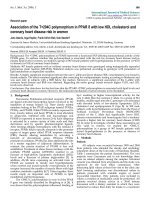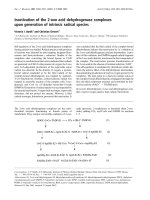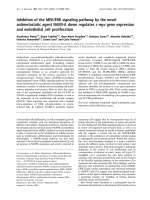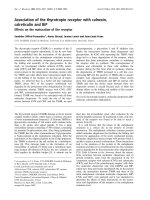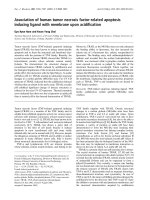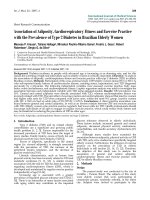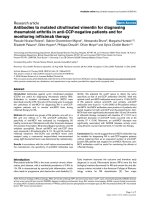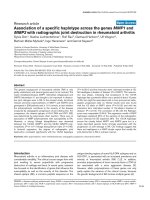Báo cáo y học: "Association of PTPN22 1858 single-nucleotide polymorphism with rheumatoid arthritis in a German cohort: higher frequency of the risk allele in male compared to female patients" potx
Bạn đang xem bản rút gọn của tài liệu. Xem và tải ngay bản đầy đủ của tài liệu tại đây (147.76 KB, 7 trang )
Open Access
Available online />Page 1 of 7
(page number not for citation purposes)
Vol 8 No 3
Research article
Association of PTPN22 1858 single-nucleotide polymorphism with
rheumatoid arthritis in a German cohort: higher frequency of the
risk allele in male compared to female patients
Matthias Pierer, Sylke Kaltenhäuser, Sybille Arnold, Matthias Wahle, Christoph Baerwald,
Holm Häntzschel and Ulf Wagner
Medical Department IV, University of Leipzig, Leipzig, Germany
Corresponding author: Matthias Pierer,
Received: 21 Dec 2005 Revisions requested: 16 Jan 2006 Revisions received: 16 Mar 2006 Accepted: 23 Mar 2006 Published: 24 Apr 2006
Arthritis Research & Therapy 2006, 8:R75 (doi:10.1186/ar1945)
This article is online at: />© 2006 Pierer et al.; licensee BioMed Central Ltd.
This is an open access article distributed under the terms of the Creative Commons Attribution License ( />),
which permits unrestricted use, distribution, and reproduction in any medium, provided the original work is properly cited.
Abstract
The functional single-nucleotide polymorphism (SNP) of the
gene PTPN22 is a susceptibility locus for rheumatoid arthritis
(RA). The study presented here describes the association of the
PTPN22 1858T allele with RA in a German patient cohort; 390
patients with RA and 349 controls were enrolled in the study.
For 123 patients, clinical and radiographic documentation over
6 years was available from the onset of disease. Genotyping of
the PTPN22 1858 SNP was performed using an restriction
fragment length polymorphism PCR-based genotyping assay.
The odds ratio to develop RA was 2.57 for carriers of the
PTPN22 1858T allele (95% confidence interval (CI) 1.85–3.58,
p < 0.001), and 5.58 for homozygotes (95% CI 1.85–16.79).
The PTPN22 1858T allele was significantly associated not only
with rheumatoid factor (RF) and anti-cyclic citrullinated peptide
(CCP) positive RA, but also with RF and anti-CCP negative
disease. The frequency of the PTPN22 1858T allele was
increased disproportionately in male patients (53.8% compared
to 33.0% in female patients, p < 0.001), and the resulting odds
ratio for male carriers was increased to 4.47 (95% CI 2.5–8.0,
p < 0.001). Moreover, within the male patient population, the
rare allele was significantly associated with the HLA-DRB1
shared epitope (p = 0.01). No significant differences in disease
activity or Larsen scores were detected. The results provide
further evidence that the PTPN22 1858T allele is associated
with RA irrespective of autoantibody production. The increased
frequency of the risk allele in male patients and its association
with the shared epitope indicate that the genetic contribution to
disease pathogenesis might be more prominent in men.
Introduction
Rheumatoid arthritis (RA) is a complex autoimmune disease
with a strong genetic contribution to its pathogenesis. Studies
on twins have shown concordance rates between 12% and
15% in monozygotic twins compared to 4% in dizygotic twins
[1]. Calculations based on these data have estimated an over-
all heritability of about 60% [2,3], indicating that genetic fac-
tors account for the majority of population susceptibility to RA.
The HLA-DRBI locus accounts for approximately one-third of
the genetically determined susceptibility to the disease [4].
The identification of further RA susceptibility loci, both in can-
didate gene approaches and genome-wide linkage studies,
was hindered in the past by difficulties to replicate such results
in other study populations. Recently, however, an association
between the minor allele (T) of a missense single-nucleotide
polymorphism (SNP; R620W (rs2476601, 1858C/T)) in the
protein tyrosine phosphatase non-receptor type 22 gene
(PTPN22) and susceptibility to RA has been described [5];
this has been confirmed in several large cohorts of patients
and controls [6-18]. Besides its association with RA, the
PTPN22 1858T allele has been found to be associated also
with type I diabetes, systemic lupus erythematosus and
autoimmune thyroiditis, suggesting a genetic predisposition
towards generalized T cell autoimmunity. The missense SNP
lies within the first proline-rich domain of PTPN22 and results
in the substitution of tryptophan for arginine at codon 620
(R620W) of PTPN22. The PTPN22 1858T variant has
recently been described to result in a gain-of-function form of
the enzyme [23], leading to stronger suppression of the early
CCP = cyclic citrullinated peptides; CI = confidence interval; OR = odds ratio; PTPN22 = protein tyrosine phosphatase non-receptor type 22; RA =
rheumatoid arthritis; RF = rheumatoid factor; RFLP = restriction fragment length polymorphism; SE = shared epitope; SNP = single-nucleotide pol-
ymorphism.
Arthritis Research & Therapy Vol 8 No 3 Pierer et al.
Page 2 of 7
(page number not for citation purposes)
T cell activation process. Possible pathogenetic mechanisms
implied by this finding include failure to delete autoreactive T
cells during thymic selection or decreased activity of regula-
tory T cells.
The aim of this study was to analyze the association of the
1858C/T SNP with RA in a sample set comprising 390 Ger-
man white RA cases and 349 healthy German white controls.
In addition, the influence of the PTPN22 1858T allele on the
clinical course of the disease and its relationship to gender,
HLA DRB1, the presence of rheumatoid factor (RF) and anti-
cyclic citrullinated peptide (CCP) antibodies was explored.
Materials and methods
RA-susceptibility cohort and control subjects
DNA was available from 390 RA patients and 349 population
control subjects. All RA patients satisfied the 1987 American
College of Rheumatology criteria for RA [24]. Of the RA
patients, 83.3% had demonstrated erosions and 74.6% were
RF positive. The median age at onset of RA was 47.0 years
(interquartile range 37 to 59 years), the median disease dura-
tion was 12.5 years (interquartile range 9 to 22 years) and
76.1% of the RA patients were female. HLA DRB1 high-reso-
lution genotyping was performed to define the shared epitope
(SE) positive DRB1*04 alleles *0401, *0404, *0405 and
*0408. In the ethnically very homogenous German population,
the alleles DRB1*0102 and *0103 are extremely rare. There-
fore, all individuals positive for DRB1*01 in low resolution typ-
ing were considered SE positive, as were all DRB1*10
positive individuals. DRB1*1402 did not occur in the study
population. HLA genotyping revealed that 30.3% of the
patients had zero copies, 42.6% had 1 copy, and 27.1% had
2 copies of the shared epitope.
Control subjects with no history of inflammatory arthritis were
recruited among healthy blood donors and from general prac-
tice registers. All patients and controls were white subjects of
German origin without discernable ethnic variation. Control
individuals were recruited with ethics committee approval and
provided their informed consent. Among the 349 population-
based control subjects, 223 (63.6%) were female and 57.3%
had zero copies, 35.3% had 1 copy, and 7.4% had 2 copies
of the SE.
The subgroup of patients (n = 123) who were analyzed for the
influence of the PTPN22 1858 SNP on radiographic progres-
sion was recruited in the outpatient clinic of the Department of
Medicine IV, Leipzig University, as part of a long term prospec-
tive observational study. RA patients with recent onset RA
were enrolled at the first presentation to a rheumatologist. The
median disease duration before study enrollment was six
months. This study population was partially overlapping with
patient cohorts reported previously, and the clinical and immu-
nogenetic characteristics did not differ from those earlier
reports [25,26].
Genotyping methods
For genotyping, cellular DNA was isolated from 10 ml of
peripheral blood using standard procedures, and 0.5 µg DNA
were used in the PCR reactions. For the determination of the
PTPN22 alleles, PCR-based restriction fragment length poly-
morphism (RFLP) analysis was performed as described previ-
ously [20]. Briefly, a fragment of the PTPN22 gene was
amplified by PCR using the forward primer 5'-TCA CCA GCT
TCC TCA ACC ACA-3' and the reverse primer 5'-GAT AAT
GTT GCT TCA ACG GAA TTT A-3'. The C→T transition at
codon 620 (NCBI refSNP ID: rs2476601) creates in the
1858T allele a restriction site for Xcm I. The polymorphism was
identified by Xcm I (New England Biolabs, Beverly, MA, USA)
restriction endonuclease digestion of the PCR amplified frag-
ment. Each digestion was resolved on 3% agarose gel,
stained with ethidium bromide and visualized by UV. Repeated
typing was performed in 10% of patient samples, with identi-
cal results in all cases.
The genotype obtained by RFLP-PCR assay was verified in 12
randomly selected samples from each genotype by direct
sequencing using the same primers (ABI 7000; Applied Bio-
systems, Foster City, CA, USA), and was confirmed in all
instances.
For HLA-DRB1 typing, genomic DNA was PCR amplified
using two primers specific for the second exon of DRB1 as
described previously [26]. Low resolution typing of DRB1 spe-
cificities was performed by oligonucleotide hybridization of the
PCR products to probes specific for DRB1*01 through *18.
Hybridization was performed in a dot-blot format with digoxi-
genin-11-ddUTP-labeled oligonucleotides. After the stringent
wash, detection was carried out using anti-digoxigenin anti-
body-alkaline phosphatase conjugate (Boehringer Mannheim,
Mannheim, Germany) and CSPD (disodium 3-(4-methoxyspiro
(1,2-dioxetane-3,2-(5'-chloro)tricyclo [3.3.1.13,7]decan)-4-
yl)phenyl phosphate; Tropix, Bedford, USA) as chemilumines-
cent substrate. For DRB1*04 subtyping, primers and oligonu-
cleotides were used as published previously [26].
Rheumatoid factor determination
RF values were determined by laser nephelometry according
to the manufacturer's instructions (Dade Behring, Liederbach,
Germany). In more than 90% of patients, repeated RF meas-
urements were available. Individuals with values ≥40 IU/ml on
at least one occasion were regarded as RF positive since this
cutoff has been established by the central laboratory facility
and is recommended for routine clinical use.
Detection of anti-CCP antibodies
A commercially available, second generation anti-CCP ELISA
(Immunoscan RA2, Generic Assays, Dahlewitz, Germany) was
used for the quantification of anti-CCP antibodies in patient
sera. A cut off of 50 units/ml was used as a stringent criterion
for anti-CCP antibody positivity.
Available online />Page 3 of 7
(page number not for citation purposes)
Statistical analysis
Allele and genotype frequencies of PTPN22 1858T were
obtained by direct counting. For allele and genotype compari-
sons, the chi-square test was used. Odds ratios (ORs) and
95% confidence intervals (95% CIs) were calculated accord-
ing to Woolf's method. Differences in medians or means
between groups were analyzed using Mann-Whitney or t test
where appropriate. Multiple logistic regression analysis was
performed to determine the influence of different genetic vari-
ables. The software used was the Sigmastat program (Systat
2004, Richmond, California, USA).
Results
Genotype frequencies for the PTPN22 1858T SNP were in
Hardy-Weinberg equilibrium in both the patient and the con-
trol cohort and all analyzed subgroups. The distribution of gen-
otypes and the resulting allele frequencies of the variant
PTPN22 1858T allele in RA patients and healthy controls are
shown in Table 1.
All genotypes containing the rare 1858T allele were found at
increased frequencies in RA patients. The CT and TT geno-
type was present in 37.9% of patients and 19.2% of healthy
controls, resulting in an OR of 2.57 (95% CI 1.85–3.58, p <
0.001). Carriage of a homozygous TT genotype was associ-
ated with an even higher OR, supporting a gene dosage effect
for the PTPN22 1858 SNP.
For the analysis of differential associations of the PTPN22
1858 SNP in clinically and immunogenetically defined sub-
groups, the RA patients were stratified for several parameters.
The ORs indicated in Table 2 show a significant association of
the risk allele genotypes with both RF positive and RF negative
RA (ORs for CT and TT genotype were 2.67 and 2.3, respec-
tively).
Stratification of the patients for anti-CCP antibody positivity
showed a similar association of PTPN22 1858T alleles with
RA, irrespective of the presence of anti-CCP antibodies (ORs
for CT and TT genotype were 2.62 and 2.63, respectively;
Table 2).
Since genetic interactions between HLA and non-HLA loci
have been described for susceptibility to RA and other autoim-
mune diseases [27], genotype distributions for the PTPN22
1858T SNP in subgroups stratified according to the number
of HLA-DRB1 SE alleles were determined and compared to
controls. In line with results reported previously, the presence
of the HLA-DRB1 SE was found to have no effect on the asso-
ciation of the PTPN22 1858T allele with the disease, since the
frequencies of the PTPN22 1858T allele in RA patients and
controls and the resulting ORs in the subgroups with zero, one
or two copies of the shared epitope were comparable (OR
2.15, p = 0.007; OR 2.59, p < 0.001; and OR 2.0, p = not
significant). The loss of significance in the subgroup analysis
Table 1
Genotype and allele frequencies of PTPN22 1858 T/C SNP in controls and patients with RA
Genotype frequency Allele frequency
CT CT and TT TT T
Controls (n = 349) 18.3 (64) 19.2 (67) 0.9 (3) 10.0 (70)
RA (n = 390) 33.3 (130) 37.9 (148) 4.6 (18) 21.3 (166)
OR (95% CI) 2.23
a
(1.59–3.13) 2.57
a
(1.85–3.58) 5.58
b
(1.85–16.79) 2.43
a
(1.81–3.26)
Values are the frequency in percent with absolute number of genotypes or alleles given in parentheses. Odds ratios (OR), 95% confidence
intervals (CI) and p values are for the comparison of frequencies of the indicated markers in the patients compared to the controls. Level of
significance:
a
p < 0.001 and
b
p < 0.005, power for all calculations α > 0.8.
Table 2
Genotype frequencies of PTPN22 1858 T/C SNP in RA patients, stratified by rheumatoid factor and anti-CCP antibody status
CT CT and TT OR for CT and TT (95% CI)
RF+ (n = 291) 34.7 (101) 38.8 (113) 2.67
a
(1.88–3.79)
RF- (n = 99) 29.3 (29) 35.4 (35) 2.3
a
(1.42–3.72)
CCP+ (n = 193) 34.7 (67) 38.3 (74) 2.62
a
(1.78–3.86)
CCP- (n = 65) 35.4 (23) 38.5 (25) 2.63
a
(1.52–4.56)
Values are the frequency in percent with absolute number of genotypes given in parentheses. Rheumatoid arthritis (RA) patients (n = 390) were
stratified by rheumatoid factor (RF) status (values ≥40 IU/ml were regarded as RF positive (RF+)). RA patients for whom anti-cyclic citrullinated
peptide (CCP) antibody concentrations were available (n = 258) were stratified according to anti-CCP positivity (values ≥50 IU/ml were regarded
as CCP positive (CCP+)). The odds ratios (ORs) and 95% confidence intervals (95% CIs) were calculated in the indicated patient subgroups in
comparison to controls. Level of significance:
a
p = 0.001, power for all calculations α > 0.9.
Arthritis Research & Therapy Vol 8 No 3 Pierer et al.
Page 4 of 7
(page number not for citation purposes)
of SE homozygous individuals is explainable by the small sam-
ple size.
Stratification of patients and controls for gender showed a sig-
nificant association of the PTPN22 1858T allele with RA in
both male and female patients compared to the appropriate
controls (Table 3). However, the frequency of a PTPN22
1858T genotype was significantly higher in male patients com-
pared to female patients (53.8% versus 33%, p < 0.001;
resulting ORs 4.47 and 2.19, respectively). In male patients,
an additional influence of the RA associated DRB1 SE was
discernible. The frequency of the 1858T allele was signifi-
cantly higher in the SE positive subgroup compared to the SE
negative patients (62.3% versus 29.2%; p = 0.01, power of
the χ
2
test with α = 0.73 below the desired level).
To analyze the independent contribution of the genetic covari-
ates to disease risk, multivariate analysis was performed.
When the presence of SE, homozygosity for SE, the presence
of the 1858T allele and homozygozity for the 1858T allele
were entered in a multiple logistic regression analysis, all of the
covariates with the exception of PTPN 1858T homozygosity
exerted significant influences on the disease risk (OR 2.19, p
< 0.001; OR 2.80, p < 0.001; OR 2.13, p < 0.001; OR 2.91,
p = 0.10). In a second, separate analysis, the presence of RA
associated DRB1*04 alleles and DRB1*01 alleles was
entered in addition to the 1858T allele, while SE status was
not included. In this logistic regression, both RA associated
DRB1 specificities exerted independent significant influences
on the disease risk (OR 3.23, p < 0.001 for DRB1*04; OR
1.95, p < 0.001 for DRB1*01), while the 1858T allele retained
its significant impact (OR 2.22, p < 0.001).
Comparison of clinical and demographic features in PTPN22
1858T allele positive and negative RA cases showed no differ-
ences in the frequency of SE carriership, the concentrations of
anti-CCP antibodies, the concentrations of IgM RF, the con-
centrations of IgA RF or the presence of erosions (data not
shown). However, the median age at disease onset of patients
carrying a PTPN22 1858T allele was 5.5 years younger com-
pared to patients without such a genotype (CT and TT geno-
type 45.5 years versus CC genotype 51.0 years; p = 0.029),
in line with a previously published report [9]. No difference in
the disease duration between both groups was discernable (p
= 0.69).
For a subgroup of the patient population, complete clinical
documentation was available starting from the first presenta-
tion in a rheumatology department, because they had been
part of a previously described prospective study for six or more
Table 3
Comparison of genotype frequencies for PTPN22 1858 SNP in patients with RA and controls stratified by sex
CT CT and TT OR for CT and TT (95% CI)
Female
Controls (n = 223) 17.9 (39) 18.4 (41) -
RA (n = 297) 28.6 (85) 33.0 (98) 2.19
a
(1.45–3.31)
Male
Controls (n = 126) 19.8 (25) 20.6 (26) -
RA (n = 93) 48.4 (45) 53.8 (50) 4.47
a
(2.51–7.96)
Values are the frequency in percent with absolute number of genotypes given in parentheses. Rheumatoid arthritis (RA) patients and controls
were stratified by sex, and odds ratios (ORs) and 95% confidence intervals (95% CIs) were calculated for carriage of the PTPN22*T allele in
comparison to controls. Level of significance:
a
p < 0.001, power for all calculations α > 0.95.
Table 4
Radiographic progression in RA patients according to the presence or absence of the PTPN22 1858T allele
CC (n = 78) CT/TT (n = 45) P value
Larsen score at study entry 0 (0–2.5) 0 (0–4.7) 0.612
Larsen score after 1 year 2.0 (0–12.2) 11.5 (0–20.0) 0.061
Larsen score after 2 years 10.0 (0–26.0) 18.5 (2.0–34.5) 0.076
Larsen score after 4 years 16.0 (2.0–30.0) 24.0 (4.7–41.5) 0.136
Larsen score after 6 years 22.0 (10.7–39.2) 37.0 (15.25–52.7) 0.159
Data are medians and interquartile range (IQR) for the comparison between PTPN22 risk allele negative and positive prospectively followed
patients (n = 123). Levels of significance are given as determined by univariate analysis, power for all comparisons α < 0.8.
Available online />Page 5 of 7
(page number not for citation purposes)
years [25,26]. In those 123 patients, the influence of the
PTPN22 1858T genotype on the clinical course of the dis-
ease, including the radiographic progression, was investi-
gated. C-reactive protein and erythrocyte sedimentation rate
did not differ between the groups defined by the PTPN22
1858 SNP. In addition, no differences in the number of swol-
len joints at study entry and after two years were observed
(data not shown).
The analysis of the progression of erosive joint destruction
was performed by comparing Larsen scores determined pro-
spectively at the indicated time points. No significant differ-
ences in the Larsen scores were found between the groups
positive and negative for the PTPN22 1858T allele. There was
a non-significant trend, however, in the positive patients
towards higher Larsen scores at several of the analyzed time
points, but not at study entry (Table 4).
Discussion
The study presented confirms the association of the PTPN22
1858T allele with RA in a study cohort of white Germans. The
genotype and allele frequencies in the healthy controls were
comparable to those reported previously in populations from
the US, Canada and Spain, and nearly identical to data
reported from Great Britain and New Zealand [5-10]. How-
ever, the carrier frequency of the 1858T allele in RA patients
was higher than in some of the published cohorts [5,7,8,10],
resulting in a somewhat higher OR for carriers to develop RA.
Possible explanations include random fluctuation and differ-
ences in sample bias because the analyzed patient cohort is
ethnically homogenous, was not recruited in a multi-center
study, and is characterized by long disease duration before
analysis.
In the first study showing association of the variant PTPN22
SNP with autoimmune disease, a gene dosage effect has
been suggested, since individuals homozygous for the
PTPN22 1858T allele were most likely to develop type I dia-
betes [20]. Our data, together with other reports, support this
hypothesis since a substantially higher susceptibility to RA
was found for individuals who were homozygous for the
1858T allele.
One important finding of the initial report about PTPN22 1858
SNP as a RA susceptibility locus was the limitation of this
association to RF positive RA [5]. Subsequently, the PTPN22
1858T allele was found to be associated with RF negative dis-
ease in several studies [7,8,10,13], while other studies repro-
duced the lack of association with RF negative disease
[9,11,15,18]. In the study cohort analyzed here, the PTPN22
1858T allele was associated not only with RF negative dis-
ease, but also with anti-CCP negative RA, which is in contrast
to two previous studies [11,18]. Sample bias as well as ethnic
differences might contribute to these discrepancies. It needs
to be emphasized, however, that our data confirm the associ-
ation of the PTPN22 1858T allele with RF and anti-CCP neg-
ative RA in a patient cohort with longstanding disease and
repeated RF and anti-CCP measurements, which makes it
unlikely that conversion to RF positive and anti-CCP positive
status could occur in carriers of the risk allele at later stages of
the disease.
An interesting finding of the study presented here is the dis-
proportionately high frequency of the PTPN22 1858T allele in
male patients suffering from RA, which results in a higher risk
to develop RA for male compared to female carriers. In the
case control study from Spain, the risk allele was also
observed in a higher frequency in male cases, but significance
was lost after correction for multiple statistical testing [7].
However, a recent study of more than 4,000 patients from
North America and Sweden has also demonstrated a signifi-
cantly stronger effect of PTPN22 in males than females [18].
Different immunogenetic associations in male and female RA
patients have also been described for several HLA DRB1 alle-
les [28,29]. One possible explanation of these findings is that
male and female RA are partially diverging disease entities,
which has been suggested previously based on clinical obser-
vations [30]. Alternatively, environmental influences like smok-
ing, which are regionally more frequently present in men [31],
might contribute to a higher rate of disease development on a
genetic background with a given disease susceptibility. Of
possible relevance in this context is the association between
the presence of the HLA DRB1 SE and the presence of the
PTPN22 1858T allele exclusively in male patients in our study.
However, the number of patients in this subgroup was small
and the phenomenon has not been observed in previous study
cohorts with larger numbers of male patients and, therefore,
warrants further investigation.
With regards to the clinical implications of the presence of the
PTPN22 1858T allele as a prognostic marker applicable in the
clinical management in early stages of the disease, no signifi-
cant differences were discernible. Nevertheless, non-signifi-
cant differences in the course of Larsen scores over six years
of observation indicate that a detailed analysis in larger pro-
spectively followed patient cohorts might yield significant
results. In a patient cohort from the UK, influences on disease
severity have indeed been reported [9], although no such influ-
ence was observed in a recent study of an inception cohort
with documented radiographic progression over four years
[11].
Conclusion
The association of RA with a missense SNP in the gene
PTPN22 could be replicated in a German population. The
PTPN22 1858T allele was found to be associated with RF
positive disease, but also with RF negative and anti-CCP anti-
body negative RA. In the male cohort, the PTPN22 1858T
allele was present in more than half of the patients, suggesting
Arthritis Research & Therapy Vol 8 No 3 Pierer et al.
Page 6 of 7
(page number not for citation purposes)
that RA in men might be a clinically more homogeneous,
genetically predetermined condition.
Competing interests
The authors declare that they have no competing interests.
Authors' contributions
MP designed the study, oversaw all aspects of the laboratory
work, analyzed the data and prepared the manuscript. SK, SA,
MW and CB participated in the collection of clinical data and
the recruitment of patients into the study. UW and HH partici-
pated in the design of the study, statistical analysis, interpreta-
tion of the results, and writing of the final manuscript.
Acknowledgements
We are grateful to the patients with RA, the control individuals, and the
collaborating clinicians for participation in this study. The work pre-
sented here was supported by a grant from the Interdisziplinäres Zen-
trum für Klinische Forschung Leipzig, Teilprojekt A 21.
References
1. Silman AJ, MacGregor AJ, Thomson W, Holligan S, Carthy D,
Farhan A, Ollier WE: Twin concordance rates for rheumatoid
arthritis: results from a nationwide study. Br J Rheumatol
1993, 32:903-907.
2. Seldin MF, Amos CI, Ward R, Gregersen PK: The genetics revo-
lution and the assault on rheumatoid arthritis. Arthritis Rheum
1999, 42:1071-1079.
3. MacGregor AJ, Snieder H, Rigby AS, Koskenvuo M, Kaprio J, Aho
K, Silman AJ: Characterizing the quantitative genetic contribu-
tion to rheumatoid arthritis using data from twins. Arthritis
Rheum 2000, 43:30-37.
4. Wordsworth P, Pile KD, Buckely JD, Lanchbury JS, Ollier B, Lath-
rop M, Bell JI: HLA heterozygosity contributes to susceptibility
to rheumatoid arthritis. Am J Hum Genet 1992, 51:585-591.
5. Begovich AB, Carlton VE, Honigberg LA, Schrodi SJ, Chokkalin-
gam AP, Alexander HC, Ardlie KG, Huang Q, Smith AM, Spoerke
JM, et al.: A missense single-nucleotide polymorphism in a
gene encoding a protein tyrosine phosphatase (PTPN22) is
associated with rheumatoid arthritis. Am J Hum Genet 2004,
75:330-337.
6. Lee AT, Li W, Liew A, Bombardier C, Weisman M, Massarotti EM,
Kent J, Wolfe F, Begovich AB, Gregersen PK: The PTPN22
R620W polymorphism associates with RF positive rheumatoid
arthritis in a dose-dependent manner but not with HLA-SE sta-
tus. Genes Immun 2005, 6:129-133.
7. Orozco G, Sanchez E, Gonzalez-Gay MA, Lopez-Nevot MA, Torres
B, Caliz R, Ortego-Centeno N, Jimenez-Alonso J, Pascual-Salcedo
D, Balsa A, et al.: Association of a functional single-nucleotide
polymorphism of PTPN22, encoding lymphoid protein phos-
phatase, with rheumatoid arthritis and systemic lupus ery-
thematosus. Arthritis Rheum 2005, 52:219-224.
8. Simkins HM, Merriman ME, Highton J, Chapman PT, O'donnell JL,
Jones PB, Gow PJ, McLean L, Pokorny V, Harrison AA, et al.:
Association of the PTPN22 locus with rheumatoid arthritis in a
New Zealand Caucasian cohort. Arthritis Rheum 2005,
52:2222-2225.
9. Steer S, Lad B, Grumley JA, Kingsley GH, Fisher SA: Association
of R602W in a protein tyrosine phosphatase gene with a high
risk of rheumatoid arthritis in a British population: evidence for
an early onset/disease severity effect. Arthritis Rheum 2005,
52:358-360.
10. Van Oene M, Wintle RF, Liu X, Yazdanpanah M, Gu X, Newman B,
Kwan A, Johnson B, Owen J, Greer W, et al.: Association of the
lymphoid tyrosine phosphatase R620W variant with rheuma-
toid arthritis, but not Crohn's disease, in Canadian popula-
tions. Arthritis Rheum 2005, 52:1993-1998.
11. Wesoly J, van der Helm-van Mil AH, Toes RE, Chokkalingam AP,
Carlton VE, Begovich AB, Huizinga TW: Association of the
PTPN22 C1858T single-nucleotide polymorphism with rheu-
matoid arthritis phenotypes in an inception cohort. Arthritis
Rheum 2005, 52:2948-2950.
12. Viken MK, Amundsen SS, Kvien TK, Boberg KM, Gilboe IM, Lilleby
V, Sollid LM, Forre OT, Thorsby E, Smerdel A, et al.: Association
analysis of the 1858C>T polymorphism in the PTPN22 gene in
juvenile idiopathic arthritis and other autoimmune diseases.
Genes Immun 2005, 6:271-273.
13. Hinks A, Barton A, John S, Bruce I, Hawkins C, Griffiths CE, Donn
R, Thomson W, Silman A, Worthington J: Association between
the PTPN22 gene and rheumatoid arthritis and juvenile idio-
pathic arthritis in a UK population: Further support that
PTPN22 is an autoimmunity gene. Arthritis Rheum 2005,
52:1694-1699.
14. Seldin MF, Shigeta R, Laiho K, Li H, Saila H, Savolainen A, Leiris-
alo-Repo M, Aho K, Tuomilehto-Wolf E, Kaarela K, et al.: Finnish
case-control and family studies support PTPN22 R620W poly-
morphism as a risk factor in rheumatoid arthritis, but suggest
only minimal or no effect in juvenile idiopathic arthritis. Genes
Immun 2005, 6:720-722.
15. Dieude P, Garnier S, Michou L, Petit-Teixeira E, Glikmans E, Pierlot
C, Lasbleiz S, Bardin T, Prum B, Cornelis F: Rheumatoid arthritis
seropositive for the rheumatoid factor is linked to the protein
tyrosine phosphatase nonreceptor 22–620W allele. Arthritis
Res Ther 2005, 7:R1200-R1207.
16. Gomez LM, Anaya JM, Gonzalez CI, Pineda-Tamayo R, Otero W,
Arango A, Martin J: PTPN22 C1858T polymorphism in Colom-
bian patients with autoimmune diseases. Genes Immun 2005,
6:628-631.
17. Zhernakova A, Eerligh P, Wijmenga C, Barrera P, Roep BO, Koe-
leman BP: Differential association of the PTPN22 coding vari-
ant with autoimmune diseases in a Dutch population. Genes
Immun 2005, 6:459-461.
18. Plenge RM, Padyukov L, Remmers EF, Purcell S, Lee AT, Karlson
EW, Wolfe F, Kastner DL, Alfredsson L, Altshuler D, et al.: Repli-
cation of Putative Candidate-Gene Associations with Rheuma-
toid Arthritis in >4,000 Samples from North America and
Sweden: Association of Susceptibility with PTPN22, CTLA4,
and PADI4. Am J Hum Genet 2005, 77:1044-1060.
19. Criswell LA, Pfeiffer KA, Lum RF, Gonzales B, Novitzke J, Kern M,
Moser KL, Begovich AB, Carlton VE, Li W, et al.: Analysis of Fam-
ilies in the Multiple Autoimmune Disease Genetics Consor-
tium (MADGC) Collection: the PTPN22 620W allele associates
with multiple autoimmune phenotypes. Am J Hum Genet
2005, 76:561-571.
20. Bottini N, Musumeci L, Alonso A, Rahmouni S, Nika K, Rostam-
khani M, MacMurray J, Meloni GF, Lucarelli P, Pellecchia M, et al.:
A functional variant of lymphoid tyrosine phosphatase is asso-
ciated with type I diabetes. Nat Genet 2004, 36:337-338.
21. Kyogoku C, Langefeld CD, Ortmann WA, Lee A, Selby S, Carlton
VE, Chang M, Ramos P, Baechler EC, Batliwalla FM, et al.:
Genetic association of the R620W polymorphism of protein
tyrosine phosphatase PTPN22 with human SLE. Am J Hum
Genet 2004, 75:504-507.
22. Smyth D, Cooper JD, Collins JE, Heward JM, Franklyn JA, Howson
JM, Vella A, Nutland S, Rance HE, Maier L, et al.: Replication of
an association between the lymphoid tyrosine phosphatase
locus (LYP/PTPN22) with type 1 diabetes, and evidence for its
role as a general autoimmunity locus. Diabetes 2004,
53:3020-3023.
23. Vang T, Congia M, Macis MD, Musumeci L, Orru V, Zavattari P,
Nika K, Tautz L, Tasken K, Cucca F, et al.: Autoimmune-associ-
ated lymphoid tyrosine phosphatase is a gain-of-function var-
iant. Nat Genet 2005, 37:1317-1319.
24. Arnett FC, Edworthy SM, Bloch DA, McShane DJ, Fries JF, Cooper
NS, Healey LA, Kaplan SR, Liang MH, Luthra HS, et al.: The Amer-
ican Rheumatism Association 1987 revised criteria for the
classification of rheumatoid arthritis. Arthritis Rheum 1988,
31:315-324.
25. Kaltenhauser S, Wagner U, Schuster E, Wassmuth R, Arnold S,
Seidel W, Troltzsch M, Loeffler M, Hantzschel H: Immunogenetic
markers and seropositivity predict radiological progression in
early rheumatoid arthritis independent of disease activity. J
Rheumatol 2001, 28:735-744.
26. Wagner U, Kaltenhauser S, Sauer H, Arnold S, Seidel W,
Hantzschel H, Kalden JR, Wassmuth R: HLA markers and predic-
Available online />Page 7 of 7
(page number not for citation purposes)
tion of clinical course and outcome in rheumatoid arthritis.
Arthritis Rheum 1997, 40:341-351.
27. Capon F, Semprini S, Dallapiccola B, Novelli G: Evidence for
interaction between psoriasis-susceptibility loci on chromo-
somes 6p21 and 1q21. Am J Hum Genet 1999, 65:1798-1800.
28. MacGregor A, Ollier W, Thomson W, Jawaheer D, Silman A: HLA-
DRB1*0401/0404 genotype and rheumatoid arthritis:
increased association in men, young age at onset, and disease
severity. J Rheumatol 1995, 22:1032-1036.
29. de Vries N, Tak PP, Tijssen H, van Riel PL, van de Putte LB:
Female sex increases risk for rheumatoid arthritis only in indi-
viduals encoding low-risk HLA-DRB1 alleles. Arthritis Rheum
2003, 48:1762-1763.
30. Weyand CM, Schmidt D, Wagner U, Goronzy JJ: The influence of
sex on the phenotype of rheumatoid arthritis. Arthritis Rheum
1998, 41:817-822.
31. Lampert T, Burger M: Smoking habits in Germany – results of
the German National Telephone Health Survey 2003. Gesund-
heitswesen 2004, 66:511-517.
